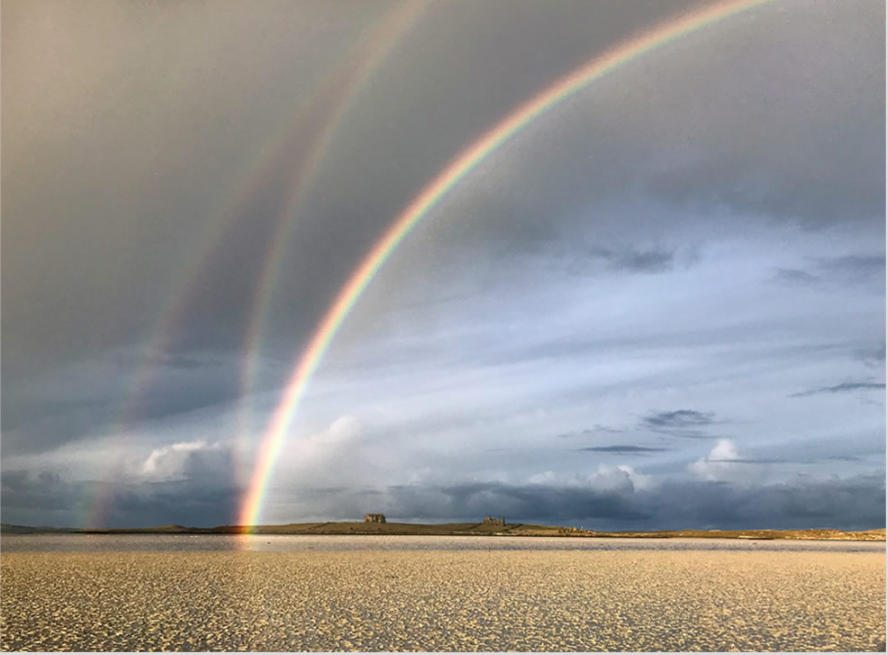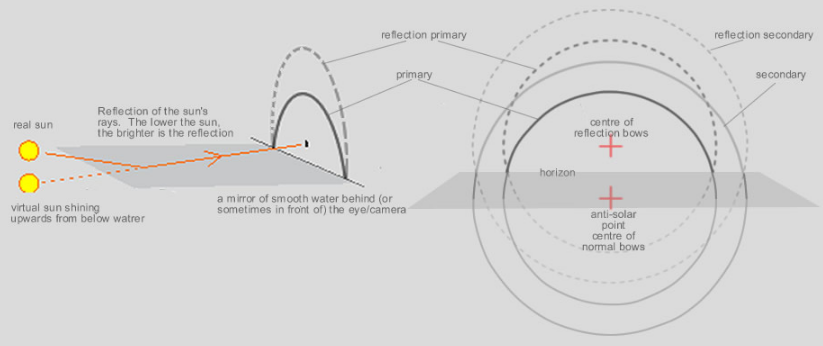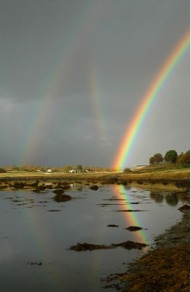North Uist Reflection Rainbows
North Uist Reflection Rainbows: A Captivating Optical Phenomenon
Have you ever witnessed a rainbow that defied the laws of nature? On the morning of December 22nd, 2018, Stephen Duffield was fortunate enough to stumble upon a mesmerizing sight while making his way to Vallay Island in North Uist, Scotland. In the vast expanse of the Outer Hebrides, he encountered an unusual group of four rainbows, each with its own distinct characteristics.
The first two rainbows, commonly known as primary and secondary bows, appeared in their traditional form, arcing across the sky. These rainbows were separated by Alexander's dark band, a dark strip of sky between the two. However, it was the other two rainbows that truly captivated Stephen's attention. These rainbows curved outward from the primary and secondary bows, creating a remarkable display.
The additional rainbows were not formed by the usual mechanism of sunlight interacting with raindrops. Instead, they were reflection rainbows, resulting from a second "sun" that seemed to shine upwards from the smooth surface of the water. The water acted as a mirror, reflecting sunlight and giving rise to this extraordinary optical phenomenon.
To understand reflection rainbows better, let's delve into the intricacies of ordinary primary and secondary rainbows. Typically, these rainbows are centered on a point below the horizon, directly opposite the position of the sun. However, when sunlight reflects off a lake or a calm sea, the raindrops responsible for creating rainbows perceive two sources of light. One is the actual sun in the sky, while the other is a virtual "sun" located at the same distance below the horizon. Consequently, both sources generate their own primary and secondary bows, resulting in an enchanting interplay of colors.
But wait, it gets even more complex! Reflection rainbows can exhibit additional features and variations depending on various factors, such as the angle of the sunlight and the smoothness of the water surface. For instance:
- The reflection rainbows may appear fainter or more diffuse compared to the primary and secondary bows.
- The reflection rainbows can curve outward or inward, depending on the angle at which the sunlight strikes the water surface.
- Under certain conditions, multiple reflection rainbows can be observed, creating a cascade of ethereal hues.
It is worth noting that reflection rainbows are just one of the many atmospheric optics phenomena that can grace our skies. Other captivating occurrences include halos, sundogs, and even the elusive green flash. Each of these events arises from the intricate interplay between sunlight, atmospheric particles, and our perception.
As we marvel at the wonders of reflection rainbows, it is essential to acknowledge the role of nature in creating these awe-inspiring spectacles. The stillness of the water's surface and the purity of raindrops contribute to the formation of these remarkable optical phenomena. Mother Nature's artistic touch reminds us of the intricate beauty that surrounds us, even in the most unexpected places.
Next time you find yourself near a calm body of water on a sunny day, take a moment to look beyond the ordinary and explore the extraordinary. Who knows what captivating optical wonders may await your gaze?

Reflection Rainbows
Stephen Duffield was on his way across to Vallay Island, North Uist in the Outer Hebrides of Scotland on the morning of 22nd December '18 when he saw this unusual group of four rainbows (the fourth at far left is faint and diffuse).
Two are 'normal' primary and secondary bows separated by the dark sky of Alexander's dark band. The others, curving outwards from them, are reflection rainbows produced by a second 'sun' shining upwards from smooth water.
Image ©Stephen Duffield, shown with permission

Ordinary primary and secondary rainbows are always centred on a point below the horizon and directly opposite the sun.
When sunlight reflects from a lake or smooth sea, rainbow forming raindrops 'see' two suns. One is in the sky, the second is the same distance below the horizon. Both suns form their own primary and secondary bows.
It gets more complicated!

Note: this article has been automatically converted from the old site and may not appear as intended. You can find the original article here.
Reference Atmospheric Optics
If you use any of the definitions, information, or data presented on Atmospheric Optics, please copy the link or reference below to properly credit us as the reference source. Thank you!
-
<a href="https://atoptics.co.uk/blog/north-uist-reflection-rainbows/">North Uist Reflection Rainbows</a>
-
"North Uist Reflection Rainbows". Atmospheric Optics. Accessed on April 25, 2024. https://atoptics.co.uk/blog/north-uist-reflection-rainbows/.
-
"North Uist Reflection Rainbows". Atmospheric Optics, https://atoptics.co.uk/blog/north-uist-reflection-rainbows/. Accessed 25 April, 2024
-
North Uist Reflection Rainbows. Atmospheric Optics. Retrieved from https://atoptics.co.uk/blog/north-uist-reflection-rainbows/.